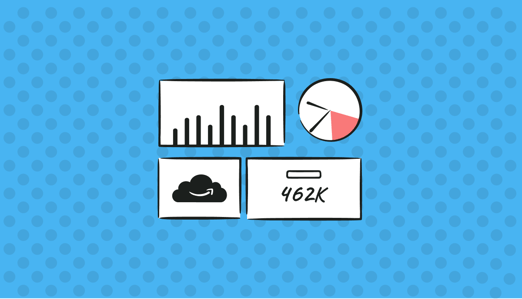
AWS cost allocation tags are key-value pairs that can be attached to AWS resources, enabling you to organize your costs and track your AWS usage with granularity. These tags are used to label resources such as instances, S3 buckets, and more, allowing you to associate costs with specific projects, departments, or billing codes in your AWS account.
By implementing these tags, you can view more detailed billing information, which facilitates better cost management and budgeting within an organization. Effective use of cost allocation tags can result in significant savings, by identifying unnecessary expenditures and optimizing resource allocations.
This is part of a series of articles about AWS Cost Management.
3 Types of AWS Cost Allocation Tags
1. AWS-Generated Cost Allocation Tags
AWS-generated cost allocation tags are automatically created by AWS when certain services are utilized. These tags are prefixed with "aws:" and are managed by AWS itself. Examples include "aws:createdBy" which indicates the service or account that created the resource.
These tags are useful for maintaining consistent tagging across services without requiring user input, making it easier to track costs associated with automatically scaled or managed services. Since these are generated and managed by AWS, they ensure a uniform tagging methodology that aids in cost analysis and supports showback initiatives.
2. User-Defined Cost Allocation Tags
User-defined cost allocation tags are created and managed by AWS users. These tags can be anything the user chooses, such as "Project", "Department", or "Environment". This allows users to tailor their cost tracking to their organizational needs and financial structure.
To use these tags for cost allocation, they must first be activated in the AWS Billing and Cost Management dashboard. Once activated, these tags appear in the cost allocation reports, helping users to track costs based on categories that make sense for their business operations.
3. Backfill Cost Allocation Tags
Backfill cost allocation tags allow users to apply tags retroactively to previously untagged resources, which helps in the accurate allocation of historical spending. This is particularly useful when implementing a cost-tracking structure mid-project or after resources have been deployed without tags.
By backfilling tags, you ensure that historical data aligns with current tagging schemes, providing a consistent and complete view of cost trends and resource utilization over time. This process supports better financial analysis and more informed decision-making regarding resource usage and budget adjustments.
How to Implement AWS Cost Allocation Tags
Implementing AWS cost allocation tags can be achieved through several methods:
Using AWS Management Console
- Open the AWS Management Console, navigate to the AWS Resource Group, then the "Tags Editor" section.
- Select the resource you want to tag and follow the instructions to add the tag.
- Repeat for any additional tags or resources.
Using AWS Resource Options
Alternatively, you can navigate to the specific AWS resource and use the "Tags" tab. Repeat for other resources.
Programmatic Tagging with AWS API
For a large number of resources or automated tagging, the AWS API can be employed. Refer to AWS Cost Explorer API documentation for further guidance.
Best Practices for Using AWS Cost Allocation Tags
Identifying Tag Requirement
Before you begin implementing AWS cost allocation tags, conduct an assessment to determine your organization's billing and operational needs. Identify which AWS resources are critical to track and the granularity of details necessary for effective cost analysis.
Engage with key stakeholders, including finance personnel, IT administrators, and departmental leaders, to gather insights on the cost centers, projects, or services that should be distinctly tagged for precise cost tracking.
Keep Tags Lightweight
For an efficient and manageable tagging system, it's important to keep the tags simple and straightforward. Avoid a complex system with an excessive number of tags or tags that are overly detailed, which can become cumbersome to manage and may lead to information overload.
Focus on establishing a minimal yet robust set of tags that encapsulate the essential information required for effective cost allocation. This not only simplifies management but also simplifies integration with cost tracking and analysis tools.
Naming Tags and Resources
Consistency and clarity are important when it comes to naming your AWS tags. Develop a clear and standardized naming convention that employs straightforward, easily understandable identifiers. This might include using prefixes or suffixes to indicate different types or purposes of resources, such as 'dev', 'test', and 'prod' for development, testing, and production environments, respectively.
It is essential that all team members involved in deploying and managing AWS resources are well-acquainted with these naming conventions. This uniformity is crucial for ensuring that the data retrieved is accurate and consistent, thereby facilitating more reliable cost analysis and financial oversight.
Tag Immediately after Enabling CUR
It is critical to begin tagging your AWS resources immediately after enabling the Cost and Usage Report (CUR) feature. Implementing tags right from the start ensures that all data captured subsequently in the CUR incorporates these tags, offering a complete and uninterrupted view of resource usage and related costs. Any delays in applying tags can create gaps in the data, complicating efforts to conduct precise cost analyses or to retroactively apply tags effectively.

1. Enforce tagging via automation from the start Use AWS Tag Policies and tools like AWS Config Rules or Terraform to enforce mandatory tags on resources upon creation. This prevents tagless resources from slipping through, ensuring consistent cost tracking and compliance across your infrastructure.
2. Implement tag inheritance for dependent resources Use automation to propagate parent resource tags to dependent or subordinate resources (e.g., volumes or snapshots). Tools like Cloud Custodian can help ensure child resources inherit the parent’s cost tags, reducing tagging gaps and ensuring full cost attribution.
3. Use dynamic tagging for scaling environments For environments that dynamically scale, such as auto-scaling groups or Kubernetes clusters, use dynamic tagging policies that tag resources automatically based on predefined rules, reducing manual intervention and preventing tagging inconsistencies during high-traffic periods.
4. Tag untaggable resources with AWS CloudWatch and Lambda For certain services or resources that don’t natively support tagging (e.g., network traffic or S3 storage requests), use custom metrics in CloudWatch combined with Lambda to track and log resource usage. This can provide more granular insights beyond what is available via standard cost allocation tags.
5. Standardize tags with cross-team input Collaborate with stakeholders from finance, operations, and development teams to create a universal tagging framework. This ensures that everyone’s needs are accounted for and prevents duplicate or inconsistent tags that dilute the value of cost reports.
Challenges and Solutions of AWS Cost Allocation Tags
AWS cost allocation tags are essential in managing and tracking cloud expenditures, but implementing them isn't always straightforward. Understanding the challenges of AWS cost allocation tags can help in devising strategies to make the most of them.
Primary Challenges of AWS Cost Allocation Tags
AWS cost allocation tags have specific challenges that users must overcome:
AWS cost allocation tags have specific challenges that users must overcome:
1. Time of Application
AWS cost allocation tags must be applied at the resource creation stage. Adding or altering tags afterward can be challenging or unfeasible.
2. Planning and Expertise Required
Effectively utilizing AWS cost allocation tags requires careful planning, knowledge, and consistent application across the organization.
3. Limited Scope
While AWS cost allocation tags provide insights into spending on each resource type, they don't offer detailed breakdowns for specific teams or projects within an AWS account.
4. Non-Retroactive Nature
AWS cost allocation tags only reflect costs after their application, limiting their use in historical data analysis. Learn more in our detailed guide to AWS cost analysis.
5. Single Account Limitation
For organizations with multiple AWS accounts, AWS cost allocation tags can only track costs within a single account.
Technical Challenges of AWS Cost Allocation Tags
Specific technical challenges make achieving accurate cost allocation with AWS cost allocation tags especially difficult:
1. Tag Propagation
Ensuring correct tagging within an AWS account can be intricate, as AWS cost allocation tags may not propagate to all associated resources.
2. Tagging Policies
Consistent enforcement of tagging policies is vital for accurate cost allocation using AWS cost allocation tags, particularly in multi-department environments.
3. Resource Ownership
Determining responsibility for shared resources can be complex, making AWS cost allocation tags less effective without clear ownership policies.
4. Cost Allocation Reports
Complex AWS environments may struggle to accurately assign costs using the AWS Cost and Usage Report (CUR), highlighting a limitation of AWS cost allocation tags.
Finout's Holistic FinOps Cloud Cost Management Solution

Finout is a holistic cost management platform that serves as a single source of truth for all your cloud costs across AWS, GCP, Kubernetes, Datadog, and Snowflake. With its intuitive interface, you can quickly and easily see where your money goes, giving you the granular data you need to make informed decisions about your AWS usage.
If you are facing challenges with AWS tagging and are looking for alternatives, you should consider Finout. With Finout’s Virtual Tags and Shared Cost features, you can remap cost filters into tag values, allowing you to track your spending across different cloud platforms and billing origins.
Virtual Tags can also combine AWS tags, Kubernetes labels, GCP namespaces, and much more into a single dashboard, making it easier to track expenses by development teams, features, and environments. Additionally, Virtual Tags solves issues with wrongly tagged AWS services or using different names for tags.
One thing that sets Finout apart from other cloud cost AWS cost monitoring tools in this regard is the fact that teams can create customizable dashboards, reports, and notifications to suit their infrastructure needs. Using Finout, teams are easily aware of any unusual spending patterns or anomalies, helping catch any potential issues early.
Finout lets you dig deep into your cloud usage and actual cost per customer, feature, or team. This gives people the visibility they need to cut costs together and make better decisions.
Leave Your Cost Allocation Challenges Behind You With Finout
AWS cost allocation tags are essential for any organization that uses AWS to manage its cloud infrastructure. However, they're not easy to manage or implement manually, making it quite challenging to get accurate cloud cost reports.
Finout is a standout cost management platform to consider. It offers a range of features, including multi-cloud cost optimization and visibility, customizable dashboard and notifications, historical reports, and comprehensive cloud cost optimization.
Book a demo with one of our specialists to get an overview of the Finout platform.








